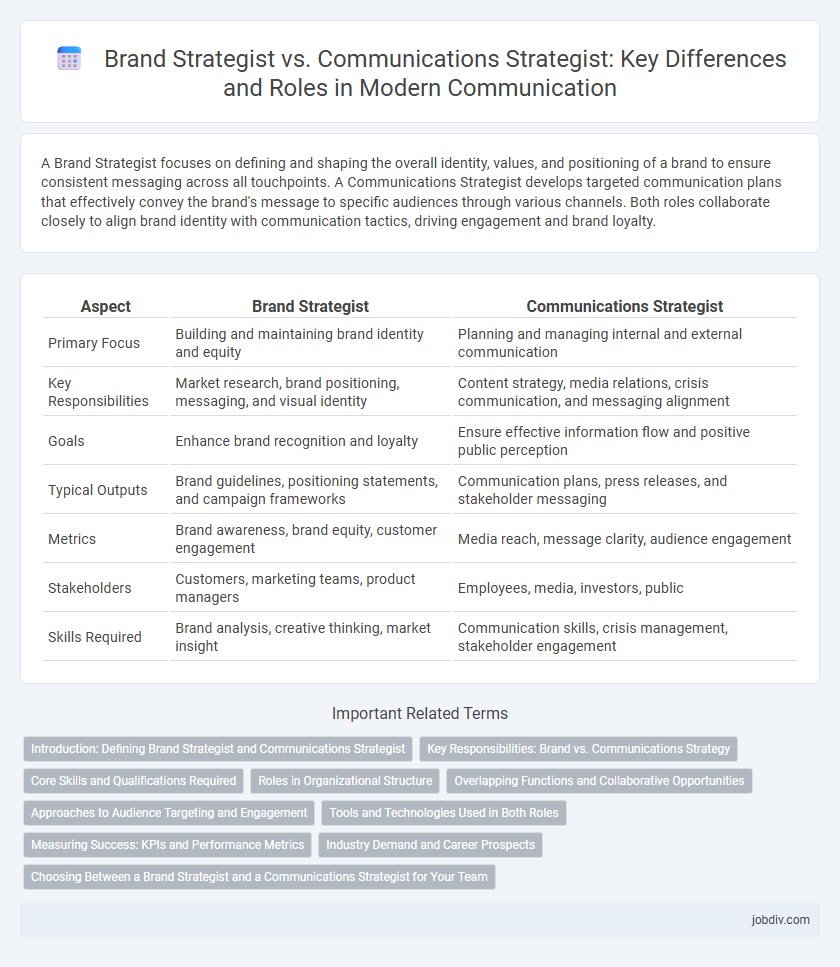A Brand Strategist focuses on defining and shaping the overall identity, values, and positioning of a brand to ensure consistent messaging across all touchpoints. A Communications Strategist develops targeted communication plans that effectively convey the brand's message to specific audiences through various channels. Both roles collaborate closely to align brand identity with communication tactics, driving engagement and brand loyalty.
Table of Comparison
| Aspect | Brand Strategist | Communications Strategist |
|---|---|---|
| Primary Focus | Building and maintaining brand identity and equity | Planning and managing internal and external communication |
| Key Responsibilities | Market research, brand positioning, messaging, and visual identity | Content strategy, media relations, crisis communication, and messaging alignment |
| Goals | Enhance brand recognition and loyalty | Ensure effective information flow and positive public perception |
| Typical Outputs | Brand guidelines, positioning statements, and campaign frameworks | Communication plans, press releases, and stakeholder messaging |
| Metrics | Brand awareness, brand equity, customer engagement | Media reach, message clarity, audience engagement |
| Stakeholders | Customers, marketing teams, product managers | Employees, media, investors, public |
| Skills Required | Brand analysis, creative thinking, market insight | Communication skills, crisis management, stakeholder engagement |
Introduction: Defining Brand Strategist and Communications Strategist
A Brand Strategist specializes in developing a cohesive brand identity that aligns with a company's core values, mission, and market positioning to influence consumer perception and loyalty. A Communications Strategist focuses on crafting and delivering targeted messages across multiple channels to effectively engage audiences and achieve specific organizational goals. Both roles intersect in shaping public perception but diverge in scope, with the Brand Strategist centered on long-term brand equity and the Communications Strategist emphasizing tactical messaging and audience interaction.
Key Responsibilities: Brand vs. Communications Strategy
Brand Strategists focus on defining and managing brand identity, ensuring consistent messaging that aligns with the company's core values and market positioning. Communications Strategists develop and implement comprehensive communication plans that target specific audiences through various channels to enhance engagement and achieve business goals. Both roles require strategic thinking but differ in scope, with Brand Strategists prioritizing brand perception and Communications Strategists emphasizing message delivery and audience interaction.
Core Skills and Qualifications Required
Brand strategists excel in market research, consumer behavior analysis, and visual identity development to enhance brand perception and loyalty. Communications strategists specialize in crafting targeted messaging, media relations, and crisis communication to maintain a consistent and effective corporate voice. Both roles require strong analytical skills, creative problem-solving, and expertise in digital communication tools to optimize stakeholder engagement.
Roles in Organizational Structure
Brand Strategists focus on shaping a company's identity by developing visual elements, messaging, and positioning to ensure a consistent brand experience across all touchpoints. Communications Strategists design and implement internal and external communication plans to effectively convey organizational goals and enhance stakeholder engagement. In organizational structures, Brand Strategists often align with marketing teams, while Communications Strategists typically collaborate closely with public relations and corporate communications departments.
Overlapping Functions and Collaborative Opportunities
Brand Strategists and Communications Strategists both play crucial roles in shaping a company's public image, with overlapping functions such as message development, audience analysis, and campaign planning. Their collaboration enhances consistency across brand identity and communication channels, ensuring that marketing efforts align seamlessly with broader business objectives. By integrating brand positioning insights with tailored communication tactics, they optimize customer engagement and reinforce brand loyalty.
Approaches to Audience Targeting and Engagement
A Brand Strategist focuses on defining and positioning a brand's identity to create emotional connections with target audiences through consistent messaging and visual design. Communication Strategists emphasize tailoring messages across channels to optimize audience engagement and drive specific actions based on data-driven insights. Both roles prioritize audience segmentation, yet Brand Strategists align targeting with long-term brand perception, while Communication Strategists aim for immediate interaction and feedback.
Tools and Technologies Used in Both Roles
Brand Strategists primarily use tools like brand management software, customer analytics platforms, and social media monitoring tools to shape brand identity and track consumer perception. Communications Strategists rely on content management systems, public relations software, and media outreach tools to craft messaging and manage communication channels. Both roles leverage data analytics and digital marketing technologies to optimize strategy effectiveness and audience engagement.
Measuring Success: KPIs and Performance Metrics
Brand Strategists measure success using KPIs like brand awareness, customer perception, and market share growth to evaluate a brand's long-term positioning and equity. Communications Strategists focus on performance metrics such as engagement rates, message reach, media impressions, and sentiment analysis to gauge the effectiveness of communication campaigns. Both roles rely on data-driven insights but prioritize different indicators aligned with their strategic objectives.
Industry Demand and Career Prospects
Brand strategists specialize in developing a company's identity and positioning to attract target customers, with increasing demand in sectors like retail, technology, and consumer goods. Communications strategists focus on managing internal and external messaging to enhance stakeholder engagement, showing strong career prospects in public relations, corporate communications, and crisis management industries. Both roles offer competitive salaries and growth opportunities, but brand strategy often commands higher demand in marketing-driven companies, while communications strategy is crucial in organizations prioritizing reputation management.
Choosing Between a Brand Strategist and a Communications Strategist for Your Team
Selecting between a Brand Strategist and a Communications Strategist hinges on your team's core objectives; a Brand Strategist drives long-term brand identity and market positioning through consumer insights and competitive analysis, while a Communications Strategist crafts targeted messaging and manages media relations to optimize engagement and brand reputation. Companies aiming to build or redefine their brand narrative benefit from a Brand Strategist's expertise in storytelling and brand architecture, whereas those focused on precise message delivery and crisis communication should prioritize hiring a Communications Strategist. Evaluating your team's needs in brand development versus communication tactics ensures the strategic alignment necessary for effective market influence and audience connection.
Brand Strategist vs Communications Strategist Infographic

 jobdiv.com
jobdiv.com